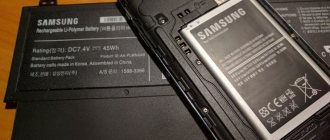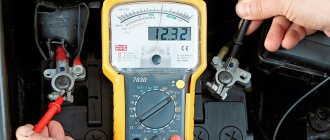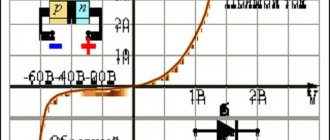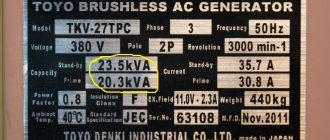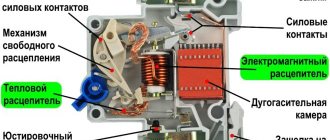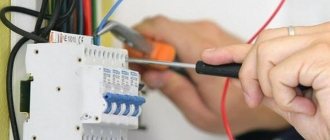Mobile devices receive energy for operation from a battery. Its main characteristic is electrical capacitance. It is measured in ampere-hours (denoted Ah). Its value, for example, 55 Ah in the battery labeling characterizes the time during which the battery will provide power to an autonomous device. True, it is necessary to clarify how it will depend on the level of energy consumption by the device itself.
Terminology, concepts, definitions
According to GOST R 53165-2008, the concept of battery capacity means “the amount of electricity, Ah, that a charged battery can supply under given conditions.” This definition seems general and non-specific, but the concept of a nominal 20-hour capacity, denoted as C20, allows you to better understand what we are talking about.
IMPORTANT - do not discharge the battery to a voltage of less than 10.5 V. In this case, it may be damaged or at least a reduction in the number of possible charge-discharge cycles.
GOST characterizes C20 as “the amount of electricity, Ah, that a charged battery delivers during a 20-hour discharge with a rated current under given conditions.” It is believed that the battery should not be discharged below 10.5 V. Based on the given voltage value, the battery shown in the photo above (55 Ah) is capable of delivering a current of 2.75 A for 20 hours, and at the same time the battery voltage does not fall below 10.5 V (55 Ah: 20 h = 2.75 A).
Expert opinion
Alexey Bartosh
Specialist in repair and maintenance of electrical equipment and industrial electronics.
Ask a Question
An interesting concept may be: nominal reserve capacity - Cρ. According to GOST, this is “the estimated discharge time (in minutes) during which the battery can produce a discharge current of 25 A to a final voltage of 10.5 V.” And also the concept - actual reserve capacity, Cρph - “the resulting discharge time for comparison with the nominal one.”
All of the above applies primarily to automotive lead-acid batteries used as starter batteries or emergency power sources. In electronic technology, lithium-ion batteries are more often used; they have their own characteristics, but the concept of electrical capacity also applies to them.
How to convert milliamp hours to amp hours or watt hours
In fact, the battery acts as a source of energy, and its power is measured in watts. Power is determined by the product of current and voltage, i.e. P = I × U. For our battery (55 Ah) it is easy to find out how many watts can be obtained from it. Based on the given formula for the data indicated on the label, the result will be equal to: 55 A·h · 12 V = 660 Wh.
Energy can be calculated in joules. The conversion is based on the ratio 1 W = 3600 J/h. Thus, the stored energy will be equal to 3600 × 660 = 2376000 J or 2.376 MJ.
Ampere-hours as a unit of measurement are a large value. It is better suited for powerful consumers (for example, cars, tractors, and other similar products. For less energy-intensive devices - mobile or autonomous devices - derivative units of measurement are often used, for example, milliamp-hours (1 ampere = 1000 milliamps).
They are designated: milliampere hour, or abbreviated as mAh. Converting units of measurement is easy, using the above ratio between ampere and milliampere. If the capacity of the phone battery is 1500 mAh, then it will be equal to 1.5 Ah (1500 mAh : 1000 = 1.5 Ah).
What is mAh? Why is the middle letter capitalized?
Yes, the spelling mAh looks a little strange, why? The letter A is capitalized because in the International System of Units, "ampere" is always represented by a capital letter A. The term "mAh" is short for "milliamp-hour" and is a way of referring to the electrical capacity of small batteries. With larger batteries, such as car batteries, amp-hours or Ah are typically used. 1 Ah = 1000 mAh.
mAh is calculated by multiplying the amount of time the battery lasts by the amps of discharge current. This may seem complicated, but it really isn't. If you have a battery and don't know its capacity, all you have to do is plug it in to provide a 1000mA discharge and time it. If the battery lasts for an hour, then you have a 1000 mAh battery. If it lasts for 7 and a half hours, then you have a 7500 mAh battery.
Battery life is inversely proportional to how frustrated you are with your smartphone. The biggest complaint we hear about a smartphone or tablet is that the battery dies in the middle of the day. If you want to have a positive experience with your phone, the mAh size is one of the first numbers you should pay attention to.
If my smartphone's battery is draining quickly, why can't I replace it with a new one?
Yes, you must be reminiscing about the old days of 2010. Nowadays it is much more difficult to find an Android device with a replaceable battery. Currently, most manufacturers make batteries non-removable.
Wait, why?
The problem we face is something of an arms race. Lithium-ion batteries really took center stage in the early nineties. Since then, technological advances have tripled the capacity density of these batteries. Impressive, right? The modern battery is only a third the size of its nineties counterpart.
Yes, that would be pretty cool... except that the number of processor transistors has increased by more than 1000 times over the same period of time. This means your phone of the future, which can run virtual reality technology and display rich 3D graphics on a gorgeous screen, runs efficiently on a battery that still hangs out like it's 1999. Computing power has outpaced battery power to such an extent that manufacturers have to go to great lengths to pack as much battery as possible into a smartphone just so it can last a day. Another problem is that people want thinner and thinner smartphones, and batteries take up a lot of space.
Put yourself in the place of the manufacturer. If the battery were to be made replaceable, it would need to be encased in a relatively bulky protective case to keep users safe. This case does not increase the capacity of the device, but it does take up space. And space inside modern smartphones is very expensive. That's why manufacturers are increasingly inclined to make smartphones with non-removable batteries.
Will it be better?
We can dream. Right now, the technologies responsible for faster data transfer, lightning-fast performance, more detailed video, heavier games and brighter screens are all moving at the speed of Moore's Law. We're just not seeing the same advancements with lithium-ion batteries.
Some scientists are looking at different materials that could be used to completely replace lithium-ion batteries, while other innovations are suddenly making older battery technologies more compact.
For example, one creative new technology introduces lithium imide electrolyte, which prevents the formation of hydrofluoric acid. This not only extends battery life and generates less heat, but also reduces battery swell.
Oh yeah, batteries swell over their lifetime, meaning smartphone makers must create cavities inside their devices to accommodate that expansion. As mentioned earlier, space is at a premium, so if you can make a battery that swells less, those precious millimeters can be spent on increasing the battery's capacity.
I think the answer here is no, it won't get better. At least in the near future, unless there is a massive breakthrough. If you're a heavy smartphone user, it might be worth buying a bulkier device with a larger mAh capacity rather than jumping on the latest razor-thin flagship.
Why are amp hours used?
Such markings make it easy to determine how long the battery will be able to supply the required current. To do this, it is enough to divide the ampere-hour data given on the label by the required current. For example, from a charged and serviceable battery with a capacity of 55 Ah, a current of 5.5 A can be obtained for 10 hours (the calculation is simple: 55 Ah: 5.5 A = 10 hours).
Of course, the estimate is approximate and does not mean that the result obtained will correspond to the forecasts. The fact is that during periodic operation of the battery (when it is sometimes connected or not to the load), when it does not release energy, its capacity is somewhat restored. In addition, if the current exceeds the permissible value, the battery may simply fail.
Expert opinion
Alexey Bartosh
Specialist in repair and maintenance of electrical equipment and industrial electronics.
Ask a Question
IMPORTANT. The battery capacity is not a constant value and depends on operating conditions, design features, and its technical condition. Therefore, it is necessary to constantly monitor the battery charge level.
We select CARKU equipment according to technical characteristics
Based on the information provided, you can choose CARKU equipment, focusing on the power of the most commonly used gadgets. For example, if you plan to connect an ASUS N73S laptop to the device, which has a lithium-polymer battery with a capacity of 4,400 mAh, determine its power and compare it with the characteristics of CARKU. To do this: 1) convert the capacity value from milliamp-hours to ampere-hours - 4,400 mAh / 1000 = 4.4 Ah; 2) multiply the resulting amp hours by the rated voltage of the lithium polymer battery - 4.4 Ah x 3.7 V = 16.28 Wh.
If you decide to buy the Carku E-Power Elite, which has a capacity of 44.4 Wh, then the laptop connected to a fully charged device will last 44.4 Wh / 16.28 Wh = 2.7 hours. The Carku E-Power-37 model with a capacity of 55.5 Wh will provide 55.5 Wh / 16.28 Wh = 3.4 hours of continuous operation.
How to determine the actual characteristics of a battery
The battery capacity can vary significantly during operation. Without touching on the specific use of the battery, it is easy to assess its actual current condition. Two methods are used for this.
- Laboratory. A pre-charged battery is discharged for a long time with a low current, recording the time during which this discharge is carried out. The capacity of a charged battery will be equal to the product of time and current. The complexity of the method lies in the use of special equipment.
- Domestic. The approach is the same, but uses a regular 55-watt low-beam or high-beam bulb, e.g. It provides a current of 4.6 A. A light bulb is connected to the pre-charged battery and the discharge time is noted. In this case, it is advisable to monitor the voltage at the battery terminals. When it reaches 10.5 V, the discharge is stopped. The product of the discharge time and the current (in our case 4.6 A) gives the battery capacity. So, if the process took 10 hours, then the battery capacity will be 46 Ah.
Using a light bulb to assess the condition of the battery will not provide the same accuracy as laboratory equipment, but it will approximately determine the current characteristics of the battery.
Companies sometimes don't have the option to write "Ah" instead of "mAh"
Manufacturers have adopted specifications for designating battery capacity. General rules were built based on the traditional calculation of battery capacity in mAh for mobile devices and most often in Wh for laptops (we talked about why there are such differences here).
Deviations from generally accepted specifications may result in losses.
For a complex technical product, any deviation from the rules, standards and restrictions can result in problems in various markets, depending on the laws of specific countries.
The tradition of denoting mobile batteries in mAh dates back to the days of batteries for cameras, common types AA and AAA, special elements for toys, radios, and so on. The specification was formed over the years and remained virtually unchanged.
What is the difference between 100Ah and 200AH battery?
No real difference in performance between a 200AH cell
and a pair of 100AH cells connected in parallel. It's likely that a 100Ah pair will weigh more than a 200Ah cell and you'll have more problems with battery interconnections. On the other hand, you might be able to accommodate twin 100AH cells better than larger 200AH cells.
Interesting materials:
Is it harmful to play games on your phone? Is radiation from phones harmful? Is it harmful to use your phone while charging? Do all VR headsets require a phone? Would you die if you dropped your phone in the bathtub? Do you hold your phone with your left hand? Should you return your old phone when upgrading? Can you rent a smartphone? Can you find my phone number? Can you send Zella's phone number?
